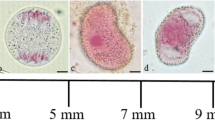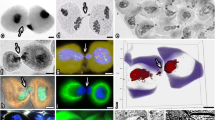Summary
The fate of plastid and mitochondrial nucleoids (pt and mt nucleoids) ofTriticum aestivum was followed during the reproductive organ formation using fluorescence microscopy after staining with 4'6-diamidino-2-phenylindole (DAPI). This investigation showed a drastic morphological change of pt nucleoids during the differentiation of reproductive organs from the shoot apex. Dot-shaped pt nucleoids grew into ring-shaped ones, which divided into small pieces in the monocellular pollen grain, as observed in this plant's earlier stage of leaf development. During the development of mature pollen grain from monocellular pollen grain, pt and/or mt nucleoids disappeared through the division of the male generative cell ofT. aestivum. Cytologically, this observation is direct evidence of the maternal inheritance of higher plants. Thus far, cytological evidence of this phenomenon has been found mostly by morphological criteria using electron microscopy, which admits some ambiguity. In the plants exemplified byLilium longiflorum, pt and/or mt nucleoids disappeared after the first pollen grain mitosis, which precededT. aestivum. In the plants exemplified byTrifolium repens, pt and/or mt nucleoids existed in the generative cells of the mature pollen grain.
The significance of these observations was discussed in relation to the interaction between nuclear and organelle genomes during plant development.
Similar content being viewed by others
Abbreviations
- DAPI 4'6:
-
diamidino-2-phenylindole
- Mt DNA:
-
Mitochondrial DNA
- Mt:
-
nucleoid Mitochondrial nucleoid
- Pt DNA:
-
Plastid DNA
- Pt:
-
nucleoid Plastid nucleoid
References
Bennet MD, Rao MK, Smith JB, Bayliss MW (1973) Cell development in the anther, the ovule, and the young seed ofTriticum aestivum L. var. Chinese Spring. Phil Trans R Soc Lond B 226: 39–81
Bonnett OT (1936) The development of the wheat spike. J Agric Res 53: 445–451
Coleman AW (1978) Visualization of chloroplast DNA with two fluorochromes. Exp Cell Res 114: 95–100
Correns C (1909) Vererbungsversuche mit blass(gelb)grünen und buntblättrigen Sippen beiMirabilis jalapa, Urtica pilulifera undLunaria annua. Z Induktive Abstammungs- und Vererbungslehre 1: 291–329
Hu S, Zhu C, Xu L, Li X, Shen J (1979) Ultrastructure of male gametophyte in wheat 1. The formation of generative and vegetative cells. Acta Bot Sinica 21: 208–214
Kuroiwa T, Suzuki T (1980) An improved method for the demonstration of in situ chloroplast nuclei in higher plant. Cell Struct Func 5: 195–197
——,Ogawa K, Kawano S (1981) The chloroplast nucleus: Distribution, number, size and shape, and a model for the multiplication of the chloroplast genome during chloroplast development. Plant Cell Physiol 22: 381–396
Kuroiwa T, Kawano S, Nishibayashi S, Sato C (1982) Epifluorescent microscopic evidence for maternal inheritance of chloroplast DNA. Nature 298: 481–483
—, (1985) Mechanisms of maternal inheritance of chloroplast DNA: an active digestion hypothesis. Microbiol Sciences 2: 62–67
—,Nakamura S (1986) No effect of preferential digestion of chloroplast genome of male origin on chloroplast genome of female orgin in young zygotes ofChlamydomonas reinhardtii as revealed by a video-intensified microscope photon counting system. Acta Histochem Cytochem 19: 95–102
Miyamura S, Nagata T, Kuroiwa T (1986) Quantitative fluorescence microscopy on dynamic changes of plastid nucleoids during wheat development. Protoplasma 133: 66–72
Nakamura S, Itoh S, Kuroiwa T (1986) Behavior of chloroplast nucleus during chloroplast development and degeneration inChlamydomonas reinhardtii. Plant Cell Physiol 27: 775–784
Sears BB (1980) Elimination of plastids during spermatogenesis and fertilization in the plant kingdom. Plasmid 4: 233–255
Smyth DR (1982) Proplastid DNA synthesis at pachytene in pollen mother cells ofLilium henryi. J Cell Sci 56: 293–302
Kirk JTO, Tilney-Bassett RAE (1978) The Plastids: their chemistry, structure, growth, and inheritance. Elsevier/North-Holland Biochemical Press, Amsterdam
Author information
Authors and Affiliations
Additional information
On leave from Department of Biology, Nagoya University, Furocho, Chikusaku, Nagoya 464, Japan.
Rights and permissions
About this article
Cite this article
Miyamura, S., Kuroiwa, T. & Nagata, T. Disappearance of plastid and mitochondrial nucleoids during the formation of generative cells of higher plants revealed by fluorescence microscopy. Protoplasma 141, 149–159 (1987). https://doi.org/10.1007/BF01272897
Received:
Accepted:
Issue Date:
DOI: https://doi.org/10.1007/BF01272897




